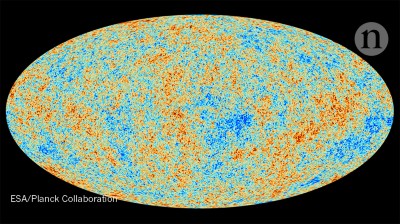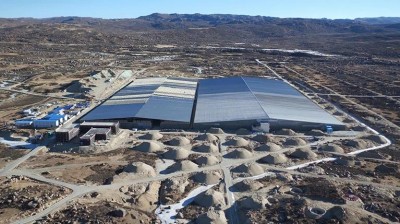[ad_1]
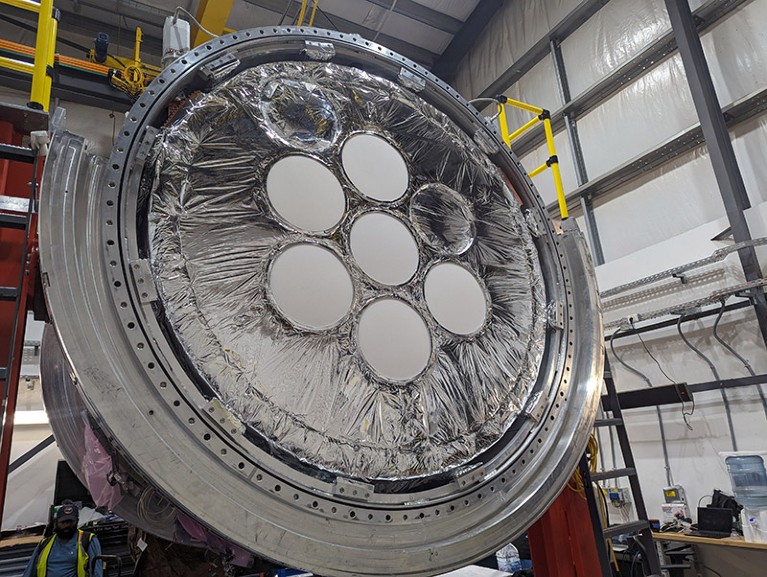
The front of the Simons Observatory’s Large Aperture Telescope Receiver, the largest receiver for observing the cosmic microwave background built so far.Credit: Mark Devlin/University of Pennsylvania
Cosmologists are preparing to cast their sharpest-ever eyes on the early Universe. From an altitude of 5,300 metres on Cerro Toco, in northern Chile’s Atacama Desert, the Simons Observatory will map the cosmic microwave background (CMB) — sometimes called the afterglow of the Big Bang — with a sensitivity up to ten times greater than that of the previous gold standard, Europe’s Planck space probe.
“It will be the best view of the CMB that we’ve ever had,” says Jo Dunkley, a cosmologist at Princeton University in New Jersey and one of the leading researchers in the observatory’s team. Construction of the US$109.5-million observatory is due to be completed in a matter of weeks.
Big Bang telescope finale marks end of an era in cosmology
One of the project’s goals is to find fingerprints left in the CMB by gravitational waves that originated from the Big Bang itself. These would provide the first incontrovertible evidence for cosmic inflation, a brief moment in which expansion is thought to have proceeded at an exponential rate. During that time, quantum fluctuations on a microscopic scale are thought to have seeded the Universe with what became its large-scale structure — including the current distribution of clusters of galaxies across space.
The scientific collaboration is led by five US universities and the Lawrence Berkeley National Laboratory in Berkeley, California. The project is named after Jim Simons, a mathematician, billionaire hedge-fund investor and philanthropist, and his wife Marilyn. The Simons Foundation in New York City contributed grants of around $90 million to build the observatory.
Once construction is complete, engineers will begin the months-long processof fine-tuning and testing the observatory’s instruments before its science programme can fully begin.
Signs of inflation
The Simons Observatory is an array of four telescopes. Three are identical 0.4-metre small aperture telescopes (SATs) and one is the 6-metre Large Aperture Telescope (LAT). Together, they will map minuscule variations in the temperature of the CMB from one patch of the sky to the next, as well as the CMB’s polarization, which is a preferential direction in which the radiation’s electric fields wiggle as the microwaves propagate through space.
China’s mountain observatory begins hunt for origins of cosmic rays
The three SATs will concentrate on a patch covering 20% of the southern sky. The aim is for them to study large-scale swirls — spanning an area several times the apparent size of the Moon in the sky — in the polarization field of the CMB. (Polarization maps look like arrays of sticks, and the orientations of the sticks can form specific swirling patterns called vortices.) It is here that the signals of cosmic inflation, known as B-mode patterns, are expected to show up.
Many cosmologists see inflation as the most plausible mechanism for the process that gave the Universe its structure, caused by an energy field called the inflaton. The nature and properties of the inflaton are mysterious. Many theories have been proposed, predicting gravitational-wave signatures of a wide range of intensities.
It is therefore not guaranteed that the signal, if it exists, is strong enough for the Simons Observatory to see it, says Suzanne Staggs, another Princeton cosmologist who is the observatory’s co-director. “But oh my gosh — if they were right there, it would be amazing.”
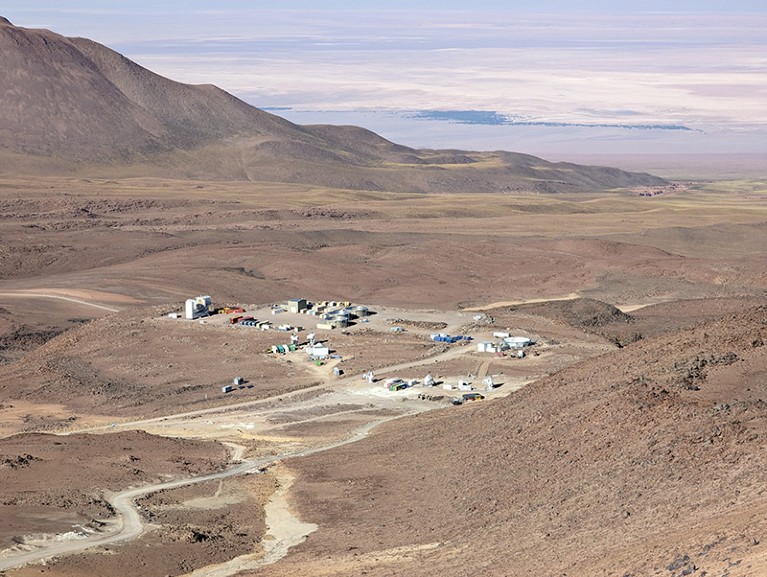
The Simons Observatory site photographed from the side of Cerro Toco in the Atacama Desert, Chile.Credit: Mark Devlin/University of Pennsylvania
The known physics of quantum fields suggests that the signatures should be within theSimons Observatory’s sensitivity range, or close to it, says Marc Kamionkowski, a theoretical astrophysicist at Johns Hopkins University in Baltimore, Maryland, who was among the first researchers to predict the existence of B-mode patterns in 19971,2.
While the SATs focus on a relatively small area, the LAT will map 40% of the sky, at much finer resolution, and record temperature fluctuations in the CMB, as well as the CMB’s polarization. Cosmologists working on Planck and other past CMB projects have been able to extract troves of information by plotting the intensity of those temperature fluctuations against the area of sky that they span. Such graphs enabled cosmologists to produce precise estimates of both the Universe’s age (13.8 billion years) and its composition (only around 4% of which is ordinary matter).
The LAT data could help researchers to detect signals of cosmic inflation in low-resolution polarization maps made by the smaller telescopes. In particular, they will be crucial for separating that pattern from spurious signals produced by effects such as dust in the Milky Way, explains Mark Devlin, a cosmologist at the University of Pennsylvania in Philadelphia who is co-director of the observatory. The experiment will be six times more sensitive to the polarization patterns than any previous attempts3 to measure them.
Exploring unknowns
However, searching for signals of inflation is only one of the project’s goals: the Simons team plans to get much more science from the observatory’s high-resolution map of the CMB. It will enable researchers not only to visualize the Universe at an early age, but also to study how its primordial radiation was affected during the 13.8 billion years it spent travelling in space, before it got to Earth.
In particular, the CMB is diverted by the gravity of large clumps of galaxies and dark matter — a phenomenon known as gravitational lensing — and this can be exploited to produce 3D maps of those clusters. Devlin, Staggs and their collaborators pioneered this technique with an earlier high-precision CMB project called the Atacama Cosmology Telescope, which was in operation from 2007 to 2022, also at Cerro Toco, and has yet to publish its final results. The Simons team will reconstruct the gravitational lensing experienced by the CMB, and determine how much of this is due to the Universe’s neutrinos. This will enable them to calculate the mass of these particles, which is still unknown. “It is a guaranteed signal,” says Brian Keating, an astrophysicist at the University of California, San Diego, who is the project’s principal investigator.
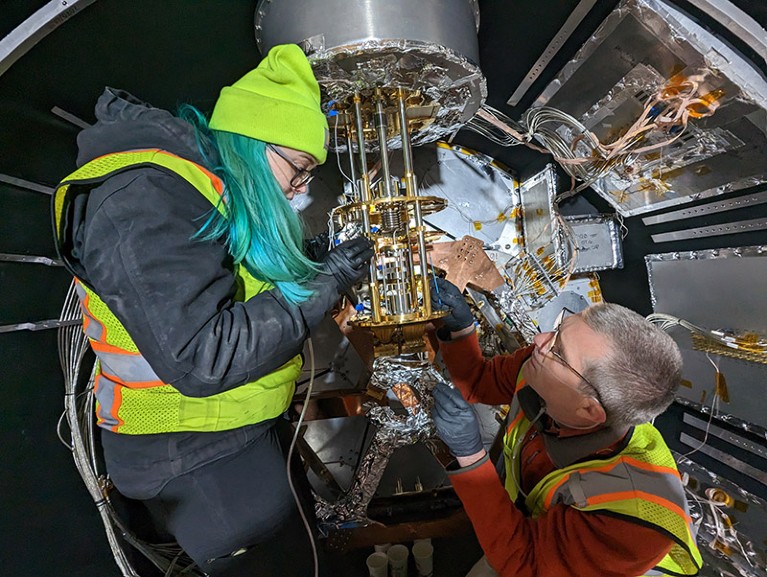
Physicists Anna Kofman and Simon Dicker at the University of Pennsylvania in Philadelphia work on the dilution refrigerator inside the Large Aperture Telescope Receiver.Credit: Mark Devlin/University of Pennsylvania
Because the LAT will be scanning the same regions of sky repeatedly over its lifetime, it will also be able to track the motion of asteroids in the Solar System and monitor active black holes at the centres of other galaxies — and how their output changes over time. “We’re going to be able to track 20,000 or more active galactic nuclei, which are, we think, supermassive black holes with jets,” Dunkley says.
Ambitious follow-up
The observatory will have two runs, each lasting about four years, with a planned $53-million upgrade in between. An even more ambitious project called CMB-S4, to be led by the US Department of Energy and the National Science Foundation, is planned as a follow-up, with observations beginning in the mid-2030s. With telescopes at both Cerro Toco and the South Pole, the $800-million array will improve sensitivity to the inflationary signal by another factor of six.
It is hoped that some of the Simons Observatory’s hardware could be reused as part of the CMB-S4, although the details have not yet been ironed out, says John Carlstrom, an astrophysicist at the University of Chicago in Illinois who is project scientist for the CMB-S4 collaboration.
In 2014, a team working on a CMB experiment at the South Pole called BICEP2 made a bold claim to have detected the inflationary signature, but later retracted it when it became clear that what they were seeing was galactic dust. Since then, direct detection of gravitational waves — coming not from the Big Bang, but from astrophysical phenomena such as pairs of black holes merging — has become routine. Cosmologists are excited to get another chance to spot the primordial signals. “We’re talking about 13.8 billion years ago, with energy densities 15 orders of magnitude larger than anything we can create in the lab,” says Kamionkowski. “It’s kind of remarkable that we can even talk about this.”
[ad_2]
Source Article Link


